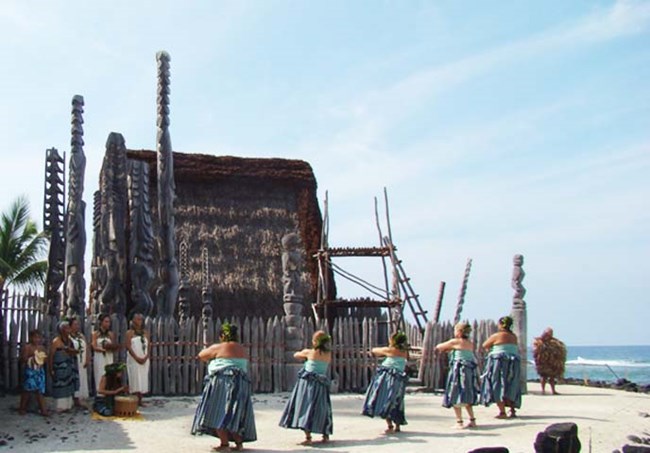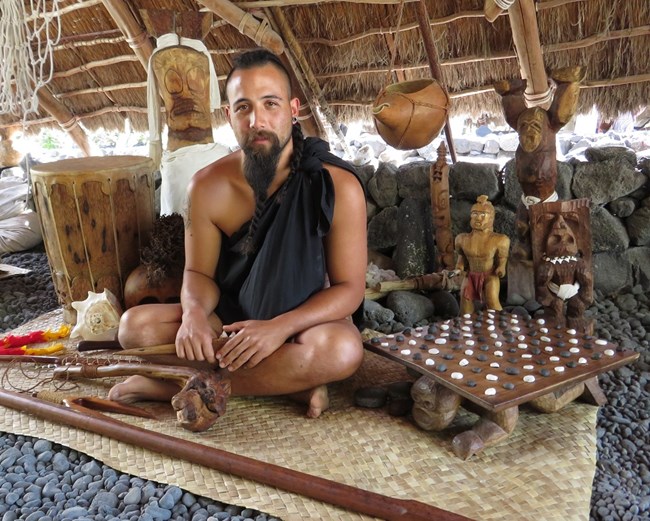Land AcknowledgementOn behalf of the National Park Service, we offer this land acknowledgement, acknowledging Hawaiʻi as an indigenous space whose original people are today identified as Native Hawaiians by the federal government. We recognize that in 1893, her majesty Queen Liliʻuokalani yielded the Hawaiian Kingdom under duress in protest to the United States to avoid the bloodshed of her people. We further recognize the generations of Kānaka Maoli and the knowledge systems and lifeways that have shaped and continue to care for Puʻuhonua o Hōnaunau to this very day. They do this so that we all can come together with humility in order to learn the history and appreciate this very special and sacred place. From the sands of Keoneʻele, in the ahupuaʻa of Hōnaunau, in the moku of Kona, on the mokupuni of Hawaiʻi, we welcome you to Puʻuhonua o Hōnaunau National Historical Park. People of Early HawaiʻiThe Hawaii of old was organized into a social structure including chiefs, priests, skilled laborers and commoners. Strict laws existed for each of the separate divisions. Na Aliʻi - The ChiefsThe aliʻi (royalty, chiefly class) in early Hawaiʻi ruled the islands. It is believed that the aliʻi could trace their ancestry back to the akua (gods) and therefore had the right to rule. The kuleana (responsibility) of the aliʻi was to care for the makaʻāinana (commoners) and the relationship with the akua.
Visit our keyboard shortcuts docs for details
Join Kahakaʻio Ravenscraft as he describes the symbols of the ʻaha aliʻi or elite circle of royalty in ancient Hawaiʻi. Kāhuna – The Priests, Experts, & AdvisorsKāhuna were not only priests and advisors to the aliʻi, but also skilled craftsmen, or experts in their field of knowledge. There were many types of kāhuna, from kāhuna pule (spiritual or religious advisors) to kāhuna lāʻau (experts in plant medicine), kālai waʻa (expert canoe maker) to kāhuna ʻanāʻanā (expert in sorcery). While there were many types of kāhuna, pule (prayer) was the foundation for all kāhuna; they all prayed and did protocol related to their expertise. Makaʻāinana – The Common PeopleThe makaʻāinana (commoners) were the people who attended to the ʻāina (land). They were farmers, fisherman, builders, craftsmen, and more. They lived and worked in the ahuapuaʻa (land divisions) and their work was overseen by the konohiki (overseer) who was in turn overseen by the aliʻi. The kuleana of the makaʻāinana was to care for the land, the community, and the aliʻi. Kānaka Maoli - Native Hawaiians Today
NPS Photo Puʻuhonua o Hōnaunau is still an active religious site for kānaka maoli (Native Hawaiians). While the National Park Service maintains the physical structure of the heiau (temple) and other features within the park, lineal descendants of the place continue to perpetuate ancestral traditions as caretakers and cultural practitioners, enabling the heiau to continue as a functioning religious site for Native Hawaiians. 
NPS Photo Kānaka Maoli PerspectivesCultural practitioner and lineal descendant caretaker Kahakaʻio Ravenscraft brings a unique perspective to his work as a National Park Service employee. Not only is he a skilled practitioner and traditional craftsman, but he is also a fantastic storyteller and a knowledgable interpreter. |
Last updated: November 13, 2022
